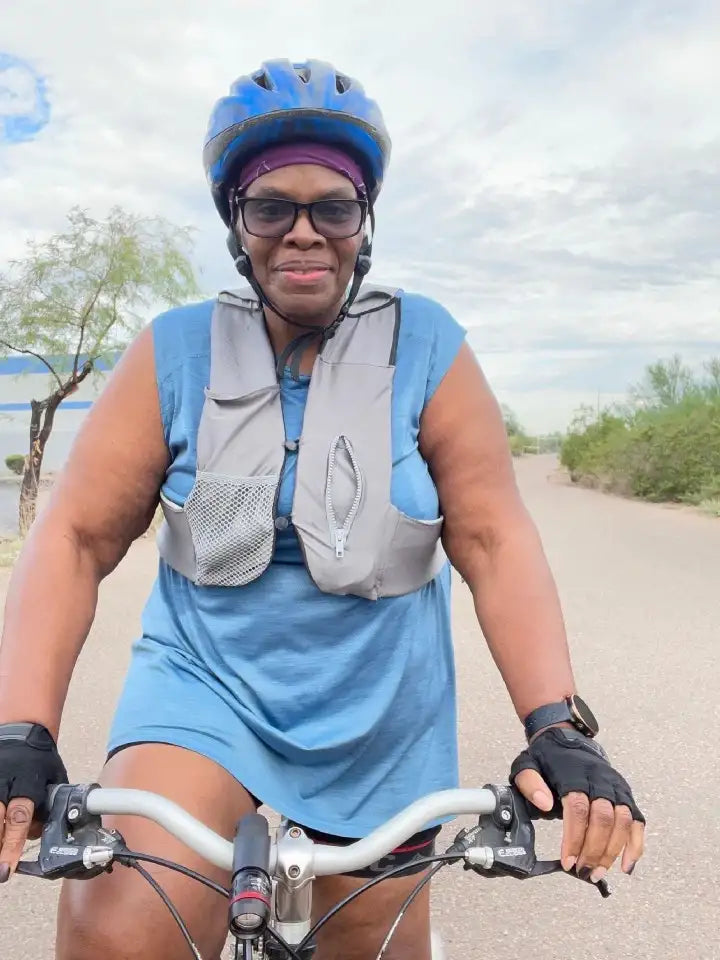
Black and Queer founder empowers a neglected segment of outdoor enthusiasts
Share
On one hand, researchers have confirmed over the last few years that nearly 70% of US adults are overweight and obese which translates to a greater need for apparel and gear in larger sizes. Yet when you walk into any retail establishment, only 30% of the products are in a size large or bigger. Charlotte Young Bowens, founder of Conscious Gear recognized as a result of her own experience a gap in the market and engages a design aesthetic centered on innovating outerwear and outdoor gear for bigger bodies. Bowens also concluded that bigger bodies are the most neglected group of outdoor consumers despite the fact that they’re also the newest and largest growing group of outdoor consumers.
But how did we get here?
According to Leah Asmelash with CNN,” In the United States, outdoor recreation and Whiteness have long gone hand in hand.” This whiteness has also included an outdoor narrative that mostly centers around thin white men. And why wouldn’t it? Let’s take into consideration the long-standing outdoor narrative that has perpetuated the fact that the idea of outdoor spaces is traditionally run by white people and is white-owned. Images of white thin men have been the predominate portrayal of what it means to be outdoors or outdoorsy

Outdoor lessons from the pandemic and before
Bowens, founder of Conscious Gear knows firsthand the struggle to find outdoor gear and outerwear for her bigger, taller, and curvier body. It all came to a head when she found herself at a crux in the road. After years of a sedentary lifestyle and consumption of nothing but processed and fast food, she ended up in an emergency room where she was newly diagnosed with high blood pressure, high blood cholesterol, borderline diabetic, and told she was morbidly obese. Not overweight or obese but the embarrassing truth that she was morbidly obese, the kind of obesity that one can die from.
With death’s door looming right in front of her face, she realized she had a choice to live or die and despite years of severe depression and daily suicidal ideation, she chose to live or at least as best she could.
On her first day at the gym, she discovered how low her level of fitness was. The most she could do was two minutes at two miles per hour on a treadmill but luckily for her, she had no context for this information and chose to use it as a starting point from which she would work to go for longer and to go faster.
No one including herself could have predicted her eventual completion of a 50-mile ultramarathon just 16 months later. “But the victory was bittersweet,” Bowens admitted because when she attempted to purchase outdoor gear and outerwear, she was unable to find much of anything that fits, and what she did settle for, ended up being extremely uncomfortable or poorly made.
She spent years complaining along with the thousands of other bigger-bodied ultramarathoners at varying races all over the US. he also spent years hacking stuff together using the sewing machine she loaned from the local public library and piecing together gently used products from the thrift store. But then the pandemic happened which afforded her time to think seriously about meeting this gap in the market for outerwear and outdoor gear for bigger bodies. With time on her hand, she surveyed hundreds of bigger-bodied runners and started the design of a hydration vest because, with plans to do more ultramarathons, this piece of outdoor gear was a pain point for her and many of her running friends.

How a fat runner becomes an outdoor gear designer
Unlike the traditional fashion industry, Bowens employed her own designed aesthetic that centered on bigger bodies and used innovation that was responsive to the nuance of bigger bodies with varying amounts of flesh. It took two years, six iterations, and feedback from over 30 fit testers before she finalized the VestaPak, a hydration vest designed by and for bigger-bodied endurance athletes and outdoor enthusiasts.
The hydration vest is only the first of many product offerings, as her research development team is working on cold-weather running apparel, a wetsuit, a cycling kit, and a summer collection of hiking and running apparel in extended sizes.
It’s true that brands are breaking into extended sizes but unlike Conscious Gear, bigger bodies are the first thought, not an afterthought. Bigger bodies are the center of the design instead of adding extra fabric to designs originally created for smaller bodies. Finally, instead of shaming bigger bodies to aspire to be smaller, Conscious Gear celebrates and empowers bigger bodies right where they are. Unlike the other brands Conscious Gear gets that bigger bodies are the new norm and honors this body type as the forethought of design innovation.
